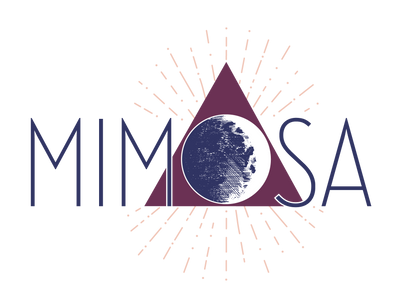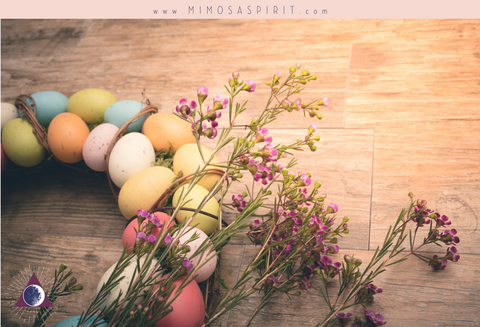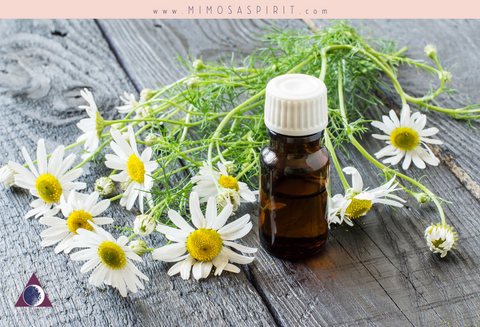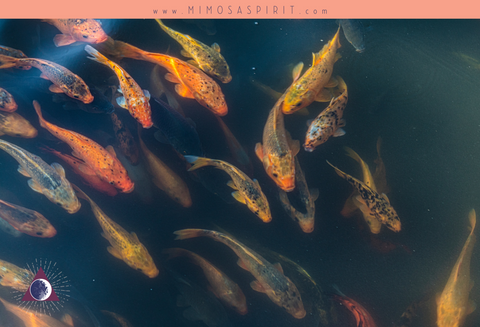
Imbolc & The Wheel of the Year
By Ashley Leavy
The Wheel of the Year is separated into 8 main holidays and is a representation of seasonal cycles that focuses on the 4 Solar Holidays of the year (also known as the quarter days) stemming from the Anglo-Saxon cultural observations of the solstices and equinoxes, with the addition of the 4 major Gaelic, agrarian, seasonal celebrations (the mid-points between the solar holidays known as the cross-quarter days or fire festivals). It represents the cycles of light and dark, and of the constant flow and unending cycle of all things from birth, growth, and death to rebirth.
The Wheel of the Year can help you tune into natural cycles (similar to the Lunar Phases but on an annual scale rather than just monthly) and helps you internalize these outward changes in nature as reflections of the growth and evolution you experience in your own life. Living in harmony with the seasons and the ebb and flow of nature helps you to lead a more soulful life and to cultivate a deeper understanding of yourself on a soul level. The Wheel of the Year helps you recognize who you are and your role in the world around you.
February 1st is Imbolc (here in the Northern Hemisphere), the first of the cross-quarter days, which marks the beginning of spring (the mid-point between the Winter Solstice and the Spring Equinox). Its origins are connected to the lambing season, or calving period when animals would begin giving milk, and the beginning of spring sowing of the ancient Celts. Though Imbolc is most widely celebrated on February 1st, it may also be celebrated on the true midpoint between the Winter Solstice and the Spring Equinox (or on the evening of the Full Moon nearest this date - or on the evening of the Full Moon in Aquarius...though some dispute this and say it’s on the New Moon in Aquarius). You may also choose to adjust the date of your Imbolc celebration to coincide with your exact location, by celebrating when the first spring flowers (like Snowdrops, Crocuses, Daffodils, Dandelions, or Primroses) emerge and bloom.

Imbolc Dates:
- February 1 (beginning at sunset on Jan. 31st and ending at sunset on Feb. 1st - or beginning at sunset on Feb. 1st and ending at sunset on Feb. 2nd, but it may have been celebrated on different dates year to year in accordance with the lactation of pregnant ewes and the blooming of Blackthorn trees)
Imbolc is also known as (or is related to):
- Imbolg (beginning at sunset on Jan. 31st and ending at sunset on Feb. 1st)
- Lá Fhéile Bríde (Feb. 1st)
- Candlemas (Feb. 2nd)
- Snowdrop Festival (Varies Year to Year - Held When Snowdrop Flowers are in Bloom)
- Saint Brigid's Day (Feb. 1st)
- Feast of Brigid (Feb. 1st)
- Feast of Torches (Feb. 2nd)
- Feast of Pan (Feb. 13th)
- Lupercalia (Feb. 13th)
- Feast of the Waxing Light (beginning at sunset on Jan. 31st and ending at sunset on Feb. 1st)
- Oimelc (beginning at sunset on Jan. 31st and ending at sunset on Feb. 1st)
- Oimelg (beginning at sunset on Jan. 31st and ending at sunset on Feb. 1st)
- Feast Day of Mary of the Candles (Feb. 2nd)
- Feast of the Purification of the Virgin (Feb. 2nd)
- Gŵyl Fair y Canhwyllau (Feb. 2nd)
- Gwyl Mair (beginning at sunset on Jan. 31st and ending at sunset on Feb. 1st)
- Februalia (Feb. 2nd)
- Groundhog Day (Feb. 2nd)
- Laa’l Breeshey (beginning at sunset on Jan. 31st and ending at sunset on Feb. 1st)
Imbolc celebrates the first inkling of Spring and welcomes in new growth and the return of warmth to the land after we’ve made our way through the darkest and coldest of the winter months. This is a celebration of hearth and home as we prepare ourselves and our spaces for the return of spring, making it the perfect time for very early garden chores and for spring cleaning your home and altar. Imbolc is a time to hold space for renewal, fertility, purification, rebirth, hope, growth, planning, and new beginnings. Imbolc’s name comes from the Gaelic phrase “in the belly” referring to the abundance of pregnant ewes at this time of year, but is also said to mean “to wash," hinting at Imbolc’s association with purification rituals and spring cleaning.
Imbolc is also a time to release what no longer serves you, shedding the darker days that are now behind you, making room for the growth that’s in store for you - spurred on by the returning of the sun.
Imbolc Key Words & Phrases:
- Renewal
- Fertility & Midwifery
- Cozy
- Love
- Purification & Cleansing
- Birth & Rebirth
- Transformation & Change
- Emergence
- Hope
- Growth
- Grief
- Initiation
- Gardening & Planting Seeds (Sprouting)
- Late Winter
- Anticipation
- Release of What No Longer Serves You
- Imagination & New Ideas
- Inklings of Spring
- Prosperity
- Spring Cleaning
- Protection
- Communication
- Planning & Preparation
- New Beginnings
- Awakening
- Creativity
- Warmth
- Return of the Light

The Goddess Brigid (later recognized by the Catholic church as St. Brigid) is associated with the High Holy Day of Imbolc (when we celebrate her as a bringer of light). Historically, there’s a record of a woman named Darlughdacha who was said to have become the abbess of Kildare monastery upon Brigid’s death. The name Darlughdacha means “Daughter of Lugh'' and the Catholic list of Saints lists her Feast Day as February 1st (Imbolc - the primary Feast Day of Goddess Brigid). It’s speculated that Darlughdacha was the historical figure associated with the Goddess Brigid and that “Brigid” was actually a title (meaning Exalted One), rather than the actual name of the Goddess.
Imbolc Goddesses, Gods, or Deities:
- Brigid (Especially in Her Maiden Aspect or as the Keeper of the Flame)
- Saint Brigid
- Saint Mary
- The Triple Goddess (changing from the Crone Cailleach Back to the Maiden Brigid)
- Arianrhod
- Danu
- Juno (in connection with Februalia)
- Dian Cecht
- Cailleach
- Gobnat
- Morgen Thitis of Avalon
- Black Goddess Kolyo
Brigid’s presence is often represented by displaying “Saint Brigid’s Cross,” a cross woven of reeds (or often three or four sheaves of wheat) joined at a square center, that’s hung in the home as a symbol of protection, fertility, abundance, and blessings. When the pre-Christian goddess was converted to a Saint by the Catholic church, devotees to Goddess Brigid hung this woven cross in their homes as a secret way of worshipping her after Ireland became predominantly Catholic. It’s common to make a new cross each Imbolc.
Ways to Celebrate Imbolc:
- Feasting
- Visiting Holy Wells or Springs in Honor of Goddess Brigid (Leaving Offerings and Praying for Health)
- Making Brigid’s Crosses from Straw or Reeds
- Divination (Especially Weather Divination or Animal Divination - looking for Serpents or Badgers to Emerge form Winter Dens)
- Planting Seeds
- Connecting with the Energy and Light of the Sun
- Leaving Strips of Cloth Outside Overnight to be Blessed by Brigid (for Healing)
- Purification & Spring Cleaning of the Home & Altar
- Churning Butter or Making Cheese
- Tie Together a Bundle of Cinnamon Sticks and Hang it in Your Sacred Space
- Creating an Imbolc Altar (Use the Correspondences in this Post for Inspiration!)
- Candle Magic (Dressing Candles or Making Dip Candles)
- Lighting Candles to Signify the Lengthening of Days and the Return of the Sun’s Light)
- Prepare Your Garden for Spring, Make Garden Plans, or Add a New Houseplant to Your Space
- Create Your Own Imbolc Tea Blend (Elderberries, Rosehips, Blackberry Leaf, & Raspberry Leaf are GREAT for this!)
- Ritually Sweep Your Home with a Broom (or Besom) for Physical & Energetic Cleansing
- Honoring Goddess Brigid (Especially Through Art, Poetry, or Smithcraft & Metalworking)
- Take a Purifying, Herbal Ritual Bath for Cleansing Your Body, Mind, & Spirit
- Donating Money to a Charitable Organization
- Resting to Honor Yourself and Reserve Energy for the Spring Days Ahead
- Blessing the Home & Family with Water from Holy Wells or Springs
- Offering Milk or Grains as an Offering to the Earth or Sea
- Meditation to Clear Mental Clutter (a Spring Cleaning for the Mind)
- Take a Stroll and Look for Signs of the Return of Spring
- Donate Items that are Cluttering Your Space

Brigid’s connection with Imbolc is no coincidence...as a goddess of the fire and the sun (as well as her connection with fertility), her presence is felt at this time of year when the cold days of winter are mostly behind us and we begin to welcome in the warmth and light of spring. An Imbolc custom to honor the Goddess Brigid is carried out by women at La Fheill Brighid. Here, on this day, an image of Brigid in her Maiden form is created, dressed in white, and placed in a woven basket (representative of a cradle). A crystal is placed over her heart (representing her purity), and the goddess is invited into the home by the female head of the household by singing sacred songs and chants to welcome her
There’s a reference, in the Carmina Gadelica, to Brigid’s connection to La Fheill Brighid, describing how a serpent came out of the mound here (the serpent, being a symbol of healing, has long been linked to Goddess Brigid). It’s said that this serpent emerges from the mound early in the morning each Imbolc in honor of the goddess.
Imbolc Symbols:
- Snowdrop Flowers
- Lanterns
- Candles
- Fig Cakes
- Flames & Fire (Especially the Sacred Triple Flame of Goddess Brigid)
- Corn Dollies
- Sun
- Light
- Cauldron
- Pumpkin Seeds
- Shamrocks & Clover Leaves
- Blackthorn Tree
- Bear
- Waxing Crescent Moon
- Brigid's Cross
- Sheep & Lambs
- Fertility Symbols
- Rooster
- Sunflower Seeds
- Triple Moon & Triple Goddess Symbol
- Woven Basket
- Brigid’s Wheel
- Doves
- Dragon
- Water (Especially from Holy Wells or Springs)
- Crocus Flowers
- Robin
- Daffodil Flowers
- Lark
- Snow
- Rowan Tree
- Rabbits & Hares
- Sycamore Tree
- Hearth
- Bread
- Root Vegetables (Potatoes, Turnips, Carrots, etc.)
- Grain & Barley
- Robin
- Reeds & Rushes
- Serpents & Snakes
- Badger or Groundhog
- Besoms & Brooms
- Cow
- Milk, Cheese, & Dairy Products
- Swan
- Poppyseed Breads or Pastries
One final Imbolc tradition to honor Goddess Brigid is to leave a loaf of bread, a pitcher of milk, and a candle out for her on this day. In Avebury, Brigid devotees climb the Silbury Hill (a neolithic earthen mound) to eat fig cakes and water in honor of Brigid.
Imbolc Crystals:
- Red Garnet
- Carnelian
- Black Onyx
- Bloodstone
- Pyrite
- Orange Calcite
- Golden Calcite
- Citrine
- Amethyst
- Azurite
- Ruby
- Golden Tiger’s Eye
- Red Jasper
- Malachite
- Peridot
- Turquoise
- White Moonstone
Imbolc Herbs & Essential Oils:
- Angelica
- Basil
- Bay Leaves
- Blackberry Fruits
- Blackberry Leaves
- Cardamon
- Cedar
- Chamomile
- Chickweed
- Cinnamon
- Clary Sage
- Clove
- Clover Flower
- Coltsfoot
- Dandelion Leaf
- Dragon's Blood Resin
- Frankincense Resin
- Ginger
- Heather
- Jasmine
- Lavender
- Licorice Root
- Myrrh Resin
- Oak Bark
- Peppermint
- Pine Resin
- Rose Flower
- Rosemary
- Vervain
- White Willow Bark
- Wormwood
Imbolc Colors:
- Purple
- Light Blue
- Dark Blue
- White
- Gold
- Light Green
- Dark Green
- Orange
- Brown
- Pink
- Red
- Yellow
- Gray
*If you live in the Southern Hemisphere, you'll be celebrating the festival of Lughnasadh today instead of Imbolc to keep with the seasonal cycles. Imbolc is usually celebrated on August 1st in the Southern hemisphere.





0 comments